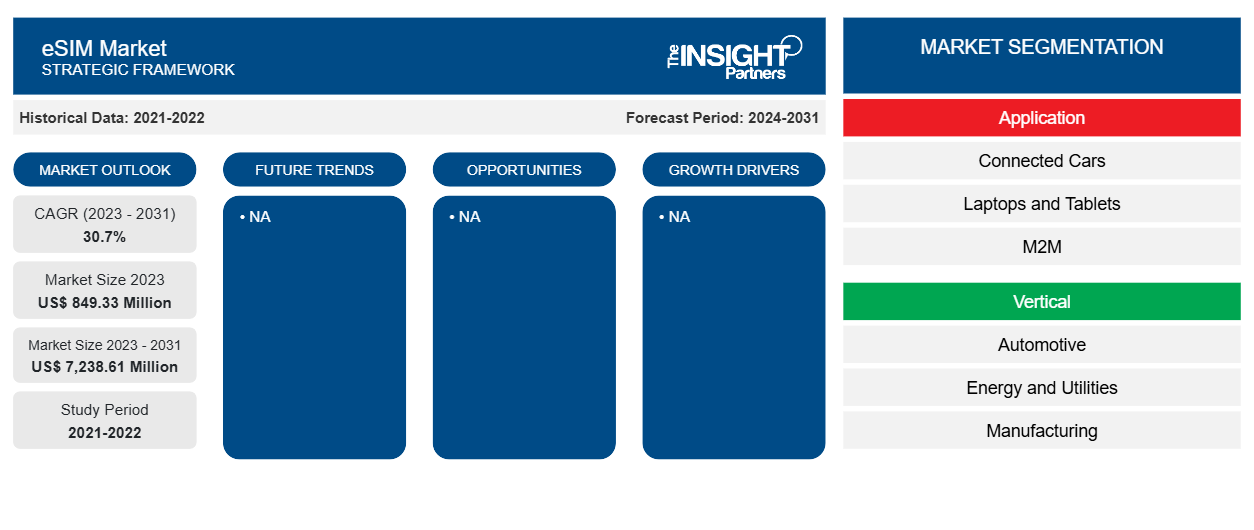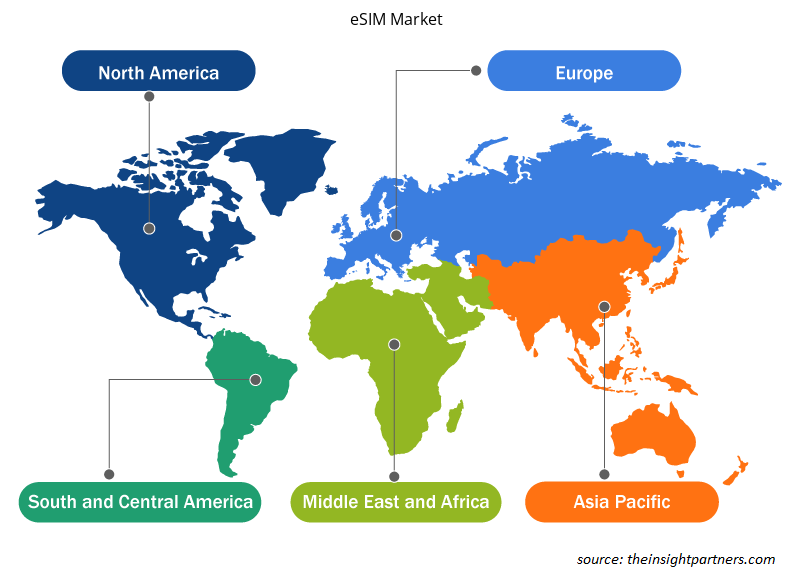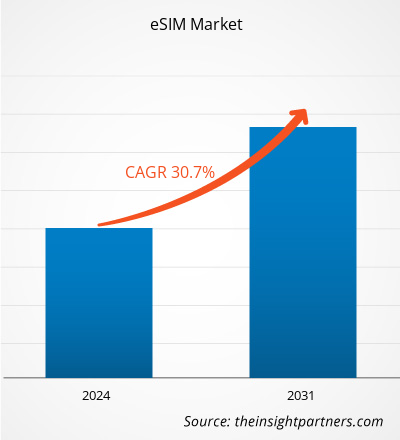Il mercato delle eSIM è stato valutato a 5,51 miliardi di dollari nel 2024 e si prevede che raggiungerà i 17,98 miliardi di dollari entro il 2031. Si stima che il mercato registrerà un CAGR del 18,7% nel periodo 2025-2031. L'integrazione dell'intelligenza artificiale nella gestione della connettività delle eSIM probabilmente porterà nuove tendenze di mercato in futuro.
Analisi di mercato eSIM
La crescente adozione di smartphone e l'integrazione dell'eSIM nel settore automobilistico, nonché i suoi vantaggi in termini di risparmio sui costi, favoriscono l'adozione dell'eSIM. La crescente integrazione della tecnologia eSIM negli smartphone sta stimolando la crescita del mercato globale dell'eSIM. Poiché i principali produttori di smartphone come Apple, Samsung e Google continuano a integrare la funzionalità eSIM nei loro ultimi modelli, la consapevolezza e l'adozione da parte dei consumatori stanno aumentando significativamente. Questo cambiamento segna un distacco dalle tradizionali schede SIM, offrendo maggiore flessibilità, sicurezza e un'esperienza utente fluida. Il 98% di tutte le connessioni smartphone in Nord America utilizzerà la tecnologia eSIM entro il 2030, secondo i dati stimati da Telna, Inc. Il primo smartphone con eSIM, Google Pixel 2, è stato lanciato da Google nel 2017. Google sta costantemente espandendo il supporto eSIM in tutta la sua serie Pixel, sottolineando il suo obiettivo strategico di progredire verso un futuro basato esclusivamente sull'eSIM.
Panoramica del mercato eSIM
Una SIM integrata (eSIM) è una tecnologia SIM digitale di nuova generazione che elimina la necessità di una scheda SIM fisica. È integrata direttamente nel dispositivo e consente agli utenti di scaricare e attivare profili di rete mobile over-the-air. Questa innovazione sta trasformando il panorama delle telecomunicazioni consentendo maggiore flessibilità, efficienza e scalabilità. L'eSIM semplifica il processo di attivazione per gli utenti finali, facilita il passaggio senza interruzioni tra i diversi operatori di rete e supporta più profili su un singolo dispositivo. Questo è particolarmente utile per chi viaggia spesso, chi lavora da remoto e chi utilizza dispositivi dual-SIM e desidera una connettività economica e ininterrotta, senza la necessità di sostituire le schede SIM. La tecnologia eSIM migliora significativamente l'efficienza operativa. Semplifica la logistica eliminando la necessità di distribuire e gestire schede SIM fisiche. È ideale per la gestione di grandi flotte di dispositivi connessi, inclusi smartphone, tablet, dispositivi indossabili e hardware IoT. I fornitori di servizi beneficiano di costi generali ridotti, di un migliore onboarding dei clienti e della possibilità di offrire servizi di connettività on-demand più personalizzati.
Riceverai la personalizzazione gratuita di qualsiasi report, incluse parti di questo report, analisi a livello nazionale, pacchetto dati Excel e potrai usufruire di fantastiche offerte e sconti per start-up e università.
Mercato eSIM: approfondimenti strategici

-
Scopri le principali tendenze di mercato di questo rapporto.Questo campione GRATUITO includerà analisi di dati che spaziano dalle tendenze di mercato alle stime e alle previsioni.
Driver e opportunità del mercato eSIM
Crescente integrazione dell'eSIM nel settore automobilistico
La tecnologia eSIM sta rapidamente guadagnando terreno nel settore automobilistico, offrendo vantaggi significativi rispetto alle tradizionali schede SIM. A differenza delle SIM rimovibili, le eSIM sono integrate direttamente nei veicoli, consentendo il provisioning remoto e la gestione centralizzata della connettività. Questa funzionalità consente una connettività continua del veicolo, supportando, tra le altre cose, aggiornamenti sul traffico in tempo reale, navigazione verso servizi nelle vicinanze, diagnostica remota, aggiornamenti software over-the-air (OTA) e accesso ai servizi di emergenza. Per gli OEM automobilistici globali, le eSIM di livello automobilistico semplificano i processi di produzione e della catena di approvvigionamento. Un design eSIM standardizzato può essere integrato in tutti i modelli di veicolo, con profili di rete forniti da remoto dopo la produzione. Ciò elimina la necessità di varianti di SIM specifiche per regione e riduce le complessità logistiche, migliorando l'efficienza operativa.
Le eSIM offrono notevoli vantaggi in termini di sicurezza. Sono integrate in fase di produzione e fungono da identificatore sicuro, crittografando le comunicazioni durante il funzionamento del veicolo, garantendo l'integrità e la privacy dei dati. L'integrazione delle eSIM come "root of trust" migliora l'affidabilità dei servizi basati sulla connettività. Inoltre, attori chiave stanno guidando l'innovazione nelle eSIM. Ad esempio, nel febbraio 2025, Thales e Cubic hanno annunciato una collaborazione strategica. Questa partnership mira a rafforzare le capacità eSIM di Cubic sfruttando la piattaforma di gestione eSIM di Thales, allineata ai più recenti standard GSMA. La collaborazione consentirà una connettività fluida e scalabile in diversi settori, tra cui automotive, trasporti e agricoltura. Con l'adozione da parte dell'industria automobilistica di architetture software-defined e mobilità connessa, la tecnologia eSIM sta emergendo come elemento fondamentale, alimentando soluzioni di connettività sicure, flessibili e coerenti a livello globale.
Aumento delle eSIM per i viaggiatori
L'adozione della tecnologia eSIM sta guadagnando un impulso costante e si prevede che sostituirà le schede SIM fisiche come metodo principale di autenticazione dei servizi mobili. Grazie alla sua natura completamente digitale e ai vantaggi intrinseci, si prevede che l'eSIM guiderà un cambiamento radicale in diversi settori, in particolare nel settore dei viaggi, durante il periodo di previsione. Secondo i dati di Mobilise Global del 2023, gli operatori del settore viaggi, in particolare le compagnie aeree, hanno osservato un aumento del 20% dei ricavi ancillari per passeggero quando i servizi ancillari vengono offerti durante la prenotazione. Inoltre, a giugno 2025, Vodafone ha introdotto una nuova piattaforma di viaggio digitale incentrata sulla sua Travel eSIM, progettata per offrire ai viaggiatori una connettività dati conveniente e affidabile, indipendentemente dal loro attuale operatore di rete mobile. Con la Travel eSIM di Vodafone, gli utenti possono facilmente aggiungere dati mobili mantenendo il proprio numero di telefono esistente, garantendo una connettività senza interruzioni all'estero. Il processo di onboarding è semplice e veloce: prima della partenza, gli utenti possono scaricare l'app dedicata o visitare il sito web della piattaforma, personalizzare o selezionare un piano dati predefinito e installare l'eSIM in pochi minuti.
I viaggiatori sono un catalizzatore chiave nell'accelerazione dell'adozione delle eSIM. Nell'attuale mondo digitalmente connesso, l'accesso ininterrotto a internet è diventato un fattore critico nelle decisioni di viaggio, con l'81% dei viaggiatori che cita la disponibilità di internet come cruciale nella scelta della destinazione. La tecnologia eSIM risponde a queste esigenze consentendo ai viaggiatori di connettersi senza interruzioni a reti locali affidabili senza l'inconveniente di dover cambiare SIM fisica, dipendere da Wi-Fi pubblici non protetti o dover affrontare tariffe di roaming eccessive. Questa connettività senza interruzioni garantisce un'esperienza mobile ininterrotta durante tutto il viaggio. Per gli operatori del settore turistico, le funzionalità digitali delle eSIM aprono nuove opportunità di diversificazione dei ricavi e di incremento dei ricavi accessori. Pertanto, si prevede che la crescente crescita delle eSIM per i viaggiatori offrirà opportunità redditizie per la crescita del mercato nei prossimi anni.
Analisi della segmentazione del rapporto di mercato eSIM
I segmenti chiave che hanno contribuito alla derivazione dell'analisi di mercato dell'eSIM sono componente e tipologia.
- In base ai componenti, il mercato è suddiviso in hardware e software e servizi. Il segmento hardware ha dominato il mercato nel 2024.
- In termini di tipologia, il mercato è segmentato in eSIM consumer, eSIM IoT ed eSIM da viaggio. Il segmento delle eSIM consumer è ulteriormente suddiviso in smartphone, laptop e tablet, dispositivi indossabili, auto connesse e altri. Il segmento delle eSIM consumer ha dominato il mercato nel 2024.
Analisi della quota di mercato delle eSIM per area geografica
- Il mercato delle eSIM è segmentato in cinque regioni principali: Nord America, Europa, Asia-Pacifico (APAC), Medio Oriente e Africa (MEA) e Sud e Centro America. Il Nord America ha dominato il mercato delle eSIM nel 2024. L'Europa è il secondo maggiore contributore al mercato globale delle eSIM, seguita dall'Asia-Pacifico.
- Il mercato delle eSIM in Nord America è suddiviso in Stati Uniti, Canada e Messico. Il mercato delle eSIM in Nord America sta crescendo rapidamente grazie alla crescente domanda di connettività flessibile, alla digitalizzazione delle telecomunicazioni e all'aumento dei viaggi transfrontalieri. Le eSIM eliminano la necessità di schede SIM fisiche, offrendo praticità, sicurezza e risparmio sui costi. eTravelSim, Airalo e altri offrono piani dati convenienti, illimitati o flessibili con un'ampia copertura negli Stati Uniti e a livello internazionale. I consumatori preferiscono servizi digitali con attivazione immediata e senza documentazione fisica. Il provisioning remoto delle SIM consente agli utenti di cambiare facilmente operatore e aiuta le aziende a semplificare la gestione dei dispositivi. Con la crescente diffusione dei dispositivi compatibili con le eSIM, il mercato si sta spostando verso soluzioni di connettività mobile completamente digitali ed efficienti.
Approfondimenti regionali sul mercato eSIM
Le tendenze e i fattori regionali che influenzano il mercato delle eSIM durante il periodo di previsione sono stati ampiamente spiegati dagli analisti di Insight Partners. Questa sezione illustra anche i segmenti e la geografia del mercato delle eSIM in Nord America, Europa, Asia-Pacifico, Medio Oriente e Africa, e Sud e Centro America.

- Ottieni i dati specifici regionali per il mercato eSIM
Ambito del rapporto di mercato eSIM
| Attributo del report | Dettagli |
|---|---|
| Dimensioni del mercato nel 2024 | 5,51 miliardi di dollari USA |
| Dimensioni del mercato entro il 2031 | 17,98 miliardi di dollari USA |
| CAGR globale (2025-2031) | 18,7% |
| Dati storici | 2021-2023 |
| Periodo di previsione | 2025-2031 |
| Segmenti coperti |
Per componente
|
| Regioni e paesi coperti |
America del Nord
|
| Leader di mercato e profili aziendali chiave |
|
Densità degli operatori del mercato eSIM: comprendere il suo impatto sulle dinamiche aziendali
Il mercato delle eSIM è in rapida crescita, trainato dalla crescente domanda degli utenti finali, dovuta a fattori quali l'evoluzione delle preferenze dei consumatori, i progressi tecnologici e una maggiore consapevolezza dei vantaggi del prodotto. Con l'aumento della domanda, le aziende stanno ampliando la propria offerta, innovando per soddisfare le esigenze dei consumatori e sfruttando i trend emergenti, alimentando ulteriormente la crescita del mercato.
La densità degli operatori di mercato si riferisce alla distribuzione delle imprese che operano in un determinato mercato o settore. Indica quanti concorrenti (operatori di mercato) sono presenti in un determinato spazio di mercato in relazione alle sue dimensioni o al suo valore totale.
Le principali aziende che operano nel mercato eSIM sono:
- Giesecke Devrient GmbH
- Telefonica SA
- Deutsche Telekom AG
- IDEMIA France SAS
- Infineon Technologies AG
- Gruppo Vodafone Plc
Disclaimer : le aziende elencate sopra non sono classificate secondo alcun ordine particolare.

- Ottieni una panoramica dei principali attori del mercato eSIM
Notizie e sviluppi recenti sul mercato eSIM
Il mercato delle eSIM viene valutato raccogliendo dati qualitativi e quantitativi a seguito di ricerche primarie e secondarie, che includono importanti pubblicazioni aziendali, dati di associazioni e database. Di seguito sono elencati alcuni sviluppi chiave nel mercato delle eSIM:
- Infineon Technologies AG ha annunciato la più piccola soluzione eSIM conforme allo standard GSMA e la prima a 28 nm del settore con il lancio di OPTIGA Connect Consumer OC1230. Questa soluzione consente un consumo energetico fino al 50% inferiore rispetto alle eSIM presenti sul mercato, prolungando la durata della batteria del dispositivo. Pensata per dispositivi mobili consumer, come dispositivi indossabili, tablet, smartphone e notebook, la soluzione eSIM contribuisce anche a una maggiore funzionalità del dispositivo.
(Fonte: Infineon Technologies AG, comunicato stampa, gennaio 2025)
- STMicroelectronics ha completato la certificazione della sua eSIM (embedded SIM) ST4SIM-300 secondo la specifica GSMA SGP.32 eSIM IoT. La ST4SIM-300 è tra le prime eSIM certificate a supportare SGP.32, la specifica adatta ai dispositivi IoT con funzionalità di interfaccia utente minime o vincoli di connettività come la comunicazione a banda stretta. Le caratteristiche distintive di SGP.32 includono il provisioning in blocco dei profili SIM per semplificare la gestione di grandi flotte di dispositivi, il provisioning senza SMS e un modello di profilo leggero per download ottimizzati.
(Fonte: STMicroelectronics, comunicato stampa, maggio 2025)
Copertura e risultati del rapporto di mercato eSIM
Il rapporto "Dimensioni e previsioni del mercato eSIM (2021-2031)" fornisce un'analisi dettagliata del mercato che copre le aree indicate di seguito:
- Dimensioni e previsioni del mercato eSIM a livello globale, regionale e nazionale per tutti i segmenti di mercato chiave coperti dall'ambito
- Tendenze del mercato eSIM, nonché dinamiche di mercato come driver, vincoli e opportunità chiave
- Analisi PEST e SWOT dettagliate
- Analisi del mercato eSIM che copre le principali tendenze del mercato, il quadro globale e regionale, i principali attori, le normative e i recenti sviluppi del mercato
- Analisi del panorama industriale e della concorrenza che copre la concentrazione del mercato, l'analisi della mappa di calore, i principali attori e gli sviluppi recenti per il mercato eSIM
- Profili aziendali dettagliati
- Analisi storica (2 anni), anno base, previsione (7 anni) con CAGR
- Analisi PEST e SWOT
- Valore/volume delle dimensioni del mercato - Globale, Regionale, Nazionale
- Industria e panorama competitivo
- Set di dati Excel
Report recenti
Testimonianze
Motivo dell'acquisto
- Processo decisionale informato
- Comprensione delle dinamiche di mercato
- Analisi competitiva
- Analisi dei clienti
- Previsioni di mercato
- Mitigazione del rischio
- Pianificazione strategica
- Giustificazione degli investimenti
- Identificazione dei mercati emergenti
- Miglioramento delle strategie di marketing
- Aumento dell'efficienza operativa
- Allineamento alle tendenze normative






















 Ottieni un campione gratuito per - Mercato eSIM
Ottieni un campione gratuito per - Mercato eSIM